3.1: Culture and Society
3.1.1: Culture and Biology
Culture relates to nature (our biology and genetics) and nurture (our environment and surroundings that also shape our identities).
Learning Objective
Examine the ways culture and biology interact to form societies, norms, rituals and other representations of culture
Key Points
- “Culture” encompasses objects and symbols, the meaning given to those objects and symbols, and the norms, values, and beliefs that pervade social life.
- Values reflect an individual’s or society’s sense of right and wrong or what “ought” to be.
- Humans also have biological drives—hunger, thirst, need for sleep—whose unfulfillment can result in death.
- Because of our biology and genetics, we have a particular form and we have certain abilities. These set essential limits on the variety of activities that humans can express culture, but there is still enormous diversity in this expression.
- Culture refers to the way we understand ourselves as individuals and as members of society, including stories, religion, media, rituals, and even language itself.
- Social Darwinism was the belief that the closer a cultural group was to the normative Western European standards of behavior and appearance, the more evolved they were.
- Culture is the non-biological or social aspects of human life.
- Culture refers to the way we understand ourselves as individuals and as members of society, including stories, religion, media, rituals, and even language itself.
- Social Darwinism hinged on the belief that the closer cultural groups were to the normative Western European standards of behavior and appearance, the more evolved they were.
Key Terms
- culture
-
The beliefs, values, behavior, and material objects that constitute a people’s way of life.
- Social Darwinism
-
a theory that the laws of evolution by natural selection also apply to social structures.
Example
- According to early beliefs about biology and culture, biological difference led to necessary cultural differences among racial groups. Today, sociologists and anthropologists recognize that the relationship between culture and biology is far more complex. For instance, prior to about 4000 BCE, most humans did not produce a protein that allowed them to digest lactose after being weaned. After Europeans began to drink the milk of domesticated animals, the genetic adaptation favoring lactose consumptions spread rapidly throughout the continent. This is an example in which cultural shifts (the domestication of animals) can lead to changes in behavior that affect biology (genetic adaptation to process lactose).
Culture and Biology
Human beings are biological creatures. We are composed of blood and bones and flesh. At the most basic level, our genes express themselves in physical characteristics, affecting bodily aspects such as skin tone and eye color. Yet, human beings are much more than our biology, and this is evident particularly in the way humans generate, and live within, complex cultures.
Defining Culture
Culture is a term used by social scientists, like anthropologists and sociologists, to encompass all the facets of human experience that extend beyond our physical fact. Culture refers to the way we understand ourselves both as individuals and as members of society, and includes stories, religion, media, rituals, and even language itself.
It is critical to understand that the term culture does not describe a singular, fixed entity. Instead, it is a useful heuristic, or way of thinking, that can be very productive in understanding behavior. As a student of the social sciences, you should think of the word culture as a conceptual tool rather than as a uniform, static definition. Culture necessarily changes, and is changed by, a variety of interactions, with individuals, media, and technology, just to name a few.
The History of Culture as a Concept
Culture is primarily an anthropological term. The field of anthropology emerged around the same time as Social Darwinism, in the late 19th and early 20th century. Social Darwinism was the belief that the closer a cultural group was to the normative, Western, European standards of behavior and appearance, the more evolved that group was. As a theory of the world, it was essentially a racist concept that persists in certain forms up to this day. If you have ever heard someone reference people of African descent as being from, or close to, the jungle, or the wilderness, you’ve encountered a type of coded language that is a modern incarnation of Social Darwinist thought.
During the late 19th and early 20th century time period, the positivist school also emerged in sociological thought. One of the key figures in this school, Cesare Lombroso, studied the physical characteristics of prisoners, because he believed that he could find a biological basis for crime. Lombroso coined the term atavism to suggest that some individuals were throwbacks to a more bestial point in evolutionary history. Lombroso used this concept to claim that certain individuals were more weak-willed, and more prone to criminal activity, than their supposedly more evolved counterparts.
In accordance with the hegemonic beliefs of the time, anthropologists first theorized culture as something that evolves in the same way biological organisms evolve. Just like biological evolution, cultural evolution was thought to be an adaptive system that produced unique results depending on location and historical moment. However, unlike biological evolution, culture can be intentionally taught and thus spread from one group of people to another.
Initially, anthropologists believed that culture was a product of biological evolution, and that cultural evolution depended exclusively on physical conditions. Today’s anthropologists no longer believe it is this simple. Neither culture nor biology is solely responsible for the other. They interact in very complex ways, which biological anthropologists will be studying for years to come.

Guildford Cathedral relief (UK)
People began domesticating cattle many years before they developed the genes for lactose tolerance.
3.1.2: Culture and Society
Culture is what differentiates one group or society from the next; different societies have different cultures.
Learning Objective
Differentiate between the various meanings of culture within society
Key Points
- Different societies have different cultures; a culture represents the beliefs and practices of a group, while society represents the people who share those beliefs and practices.
- Material culture refers to the objects or belongings of a group of people, such as automobiles, stores, and the physical structures where people worship. Nonmaterial culture, in contrast, consists of the ideas, attitudes, and beliefs of a society.
- In 18th and 19th century Europe, the term “culture” was equated with civilization and considered a unique aspect of Western society. Remnants of that colonial definition of culture can be seen today in the idea of “high culture”.
- During the Romantic Era, culture became equated with nationalism and gave rise to the idea of multiple national cultures.
- Today, social scientists understand culture as a society’s norms, values, and beliefs; as well as its objects and symbols, and the meaning given to those objects and symbols.
Key Terms
- popular culture
-
The prevailing vernacular culture in any given society, including art, cooking, clothing, entertainment, films, mass media, music, sports, and style
- civilization
-
An organized culture encompassing many communities, often on the scale of a nation or a people; a stage or system of social, political or technical development.
- high culture
-
The artistic entertainment and material artifacts associated with a society’s aristocracy or most learned members, usually requiring significant education to be appreciated or highly skilled labor to be produced.
- nationalism
-
The idea of supporting one’s country and culture; patriotism.
Example
- Classical music was once considered a marker of culture itself. Societies that had not developed classical music (or other such practices) were considered uncultured and uncivilized. Popular and indigenous music were not considered part of culture. Today, however, all music is considered part of culture. Different cultures may embrace different types of music, from pop or rock to world music or classical music.
Culture encompasses human elements beyond biology: for example, our norms and values, the stories we tell, learned or acquired behaviors, religious beliefs, art and fashion, and so on. Culture is what differentiates one group or society from the next.
Different societies have different cultures; however it is important not to confuse the idea of culture with society. A culture represents the beliefs and practices of a group, while society represents the people who share those beliefs and practices. Neither society nor culture could exist without the other.
Defining Culture
Almost every human behavior, from shopping to marriage to expressions of feelings, is learned. Behavior based on learned customs is not necessarily a bad thing – being familiar with unwritten rules helps people feel secure and confident that their behaviors will not be challenged or disrupted. However even the simplest actions – such as commuting to work, ordering food from a restaurant, and greeting someone on the street – evidence a great deal of cultural propriety.
Material culture refers to the objects or belongings of a group of people (such as automobiles, stores, and the physical structures where people worship). Nonmaterial culture, in contrast, consists of the ideas, attitudes, and beliefs of a society. Material and nonmaterial aspects of culture are linked, and physical objects often symbolize cultural ideas. A metro pass is a material object, but it represents a form of nonmaterial culture (namely capitalism, and the acceptance of paying for transportation). Clothing, hairstyles, and jewelry are part of material culture, but the appropriateness of wearing certain clothing for specific events reflects nonmaterial culture. A school building belongs to material culture, but the teaching methods and educational standards are part of education’s nonmaterial culture.
These material and nonmaterial aspects of culture can vary subtly from region to region. As people travel farther afield, moving from different regions to entirely different parts of the world, certain material and nonmaterial aspects of culture become dramatically unfamiliar. As we interact with cultures other than our own, we become more aware of our own culture – which might otherwise be invisible to us – and to the differences and commonalities between our culture and others.
The History of “Culture”
Some people think of culture in the singular, in the way that it was thought of in Europe during the 18th and early 19th centuries: as something achieved through evolution and progress. This concept of culture reflected inequalities within European societies and their colonies around the world; in short, it equates culture with civilization and contrasts both with nature or non-civilization. According to this understanding of culture, some countries are more “civilized” than others, and some people are therefore more “cultured” than others.
When people talk about culture in the sense of civilization or refinement, they are really talking about “high culture,” which is different from the sociological concept of culture. High culture refers to elite goods and activities, such as haute cuisine, high fashion or couture, museum-caliber art, and classical music. In common parlance, people may refer to others as being “cultured” if they know about and take part in these activities. Someone who uses culture in this sense might argue that classical music is more refined than music by working-class people, such as jazz or the indigenous music traditions of aboriginal peoples. Popular (or “pop”) culture, by contrast, is more mainstream and influenced by mass media and the common opinion. Popular culture tends to change as tastes and opinions change over time, whereas high culture generally stays the same throughout the years. For example, Mozart is considered high culture, whereas Britney Spears is considered pop culture; Mozart is likely to still be popular in 100 years, but Britney Spears will likely be forgotten by all but a few.

Aboriginal culture
Early colonial definitions of culture equated culture and civilization and characterized aboriginal people as uncivilized and uncultured.
This definition of culture only recognizes a single standard of refinement to which all groups are held accountable. Thus, people who differ from those who believe themselves to be “cultured” in this sense are not usually understood as having a different culture; they are understood as being uncultured.
Although we still see remnants of this idea of high culture today, it has largely fallen out of practice. Its decline began during the Romantic Era, when scholars in Germany – especially those concerned with nationalism – developed the more inclusive notion of culture as a distinct worldview. Although more inclusive, this approach to culture still allowed for distinctions between so-called “civilized” and “primitive” cultures. By the late 19th century, anthropologists changed the concept of culture to include a wider variety of societies, ultimately resulting in the concept of culture adopted by social scientists today: objects and symbols, the meaning given to those objects and symbols, and the norms, values, and beliefs that pervade social life.
This new perspective has also removed the evaluative element of the concept of culture; it distinguishes among different cultures, but does not rank them. For instance, the high culture of elites is now contrasted with popular or pop culture. In this sense, high culture no longer refers to the idea of being “cultured,” as all people have culture. High culture simply refers to the objects, symbols, norms, values, and beliefs of a particular group of people; popular culture does the same.

High culture
Ballet is traditionally considered a form of “high culture”.
3.1.3: Cultural Universals
A cultural universal is an element, pattern, trait, or institution that is common to all human cultures worldwide.
Learning Objective
Discuss cultural universals in terms of the various elements of culture, such as norms and beliefs
Key Points
- Cultural universals are elements, patterns, traits, or institutions that are common to all human cultures worldwide.
- There is a tension in cultural anthropology and cultural sociology between the claim that culture is a universal and that it is also particular. The idea of cultural universals runs contrary in some ways to cultural relativism which was, in part, a response to Western ethnocentrism.
- Ethnocentrism may take obvious forms. For example, the belief that one people’s culture is the most beautiful and true. Franz Boas understood “culture” to include not only certain tastes in food, art, and music, or beliefs about religion but instead assumed a much broader notion of culture.
- Among the cultural universals listed by Donald Brown (1991) are abstract speech, figurative speech and metaphors, antonyms and synonyms, and units of time.
- Among the cultural universals listed by Brown, some were investigated by Franz Boas. For example, Boas saw language as a means of categorizing experiences. Thus, although people may perceive visible radiation similarly, people who speak different languages slice up the continuum in different ways.
- Since Franz Boas, two debates have dominated cultural anthropology.
Key Terms
- universal
-
Common to all society; worldwide.
- particular
-
A specific case; an individual thing as opposed to a whole class.
- culture
-
The beliefs, values, behavior, and material objects that constitute a people’s way of life.
Example
- The incest taboo is often cited as an example of a cultural universal. Though there are a few counterexamples, nearly every society since the beginning of recorded history has had a taboo against sibling or parent/child marriages.
The sociology of culture concerns culture—usually understood as the ensemble of symbolic codes used by a society—as it is manifested in society. The elements of culture include (1) symbols (anything that carries particular meaning recognized by people who share the same culture); (2) language (system of symbols that allows people to communicate with one another); (3) values (culturally-defined standards that serve as broad guidelines for social living; (4) beliefs (specific statements that people hold to be true); and (5) norms (rules and expectations by which a society guides the behavior of its members). While these elements of culture may be seen in various contexts over time and across geography, a cultural universal is an element, pattern, trait, or institution that is common to all human cultures worldwide. Taken together, the whole body of cultural universals is known as the human condition. Among the cultural universals listed by Donald Brown (1991) are abstract speech, figurative speech and metaphors, antonyms and synonyms, and units of time.

First-Cousin Marriage Laws in the U.S.
In states marked dark blue, first-cousin marriage is legal. Light blue signifies that it is legal but has restrictions or exceptions. Pink signifies that it is banned with exceptions; red signifies that it is banned via statute, and dark red signifies that it is a criminal offense.
The concept of a cultural universal has long been discussed in the social sciences. Cultural universals are elements, patterns, traits, or institutions that are common to all human cultures worldwide. There is a tension in cultural anthropology and cultural sociology between the claim that culture is a universal (the fact that all human societies have culture), and that it is also particular (culture takes a tremendous variety of forms around the world). The idea of cultural universals—that specific aspects of culture are common to all human cultures—runs contrary to cultural relativism. Cultural relativism was, in part, a response to Western ethnocentrism. Ethnocentrism may take obvious forms, in which one consciously believes that one people’s arts are the most beautiful, values the most virtuous, and beliefs the most truthful. Franz Boas argued that one’s culture may mediate and thus limit one’s perceptions in less obvious ways. He understood “culture” to include not only certain tastes in food, art, and music, or beliefs about religion but instead assumed a much broader notion of culture.
Among the cultural universals listed by Donald Brown, some of these were investigated by Franz Boas. For example, Boas called attention to the idea that language is a means of categorizing experiences, hypothesizing that the existence of different languages suggests that people categorize, and thus experience, language differently. Therefore, although people may perceive visible radiation the same way, in terms of a continuum of color, people who speak different languages slice up this continuum into discrete colors in different ways.
3.1.4: Culture Shock
Culture shock is the personal disorientation a person may feel when experiencing an unfamiliar way of life in a new country.
Learning Objective
Discuss culture shock in terms of its four phases – honeymoon, negotiation, adjustment and mastery
Key Points
- Culture shock is the personal disorientation a person may feel when experiencing an unfamiliar way of life due to immigration or a visit to a new country.
- Culture shock can be described as consisting of at least one of four distinct phases: honeymoon, negotiation, adjustment, and mastery.
- During the honeymoon phase, the differences between the old and new culture are seen in a romantic light.
- After some time (usually around three months, depending on the individual), differences between the old and new culture become apparent and may create anxiety. This is the mark of the negotiation phase.
- In the adjustment phase, one grows accustomed to the new culture and develops routines.
- Lastly, in the mastery stage, assignees are able to participate fully and comfortably in the host culture.
- In the Adjustment phase, one grows accustomed to the new culture and develops routines.
- One knows what to expect in most situations and the host country no longer feels all that new.
- Lastly, in the Mastery stage, assignees are able to participate fully and comfortably in the host culture.
Key Term
- biculturalism
-
The state or quality of being bicultural.
Culture shock is the personal disorientation a person may feel when experiencing an unfamiliar way of life due to immigration or a visit to a new country, or to a move between social environments. One of the most common causes of culture shock involves individuals in a foreign country. There is no true way to entirely prevent culture shock, as individuals in any society are personally affected by cultural contrasts differently.
Culture shock can be described as consisting of at least one of four distinct phases: honeymoon, negotiation, adjustment, and mastery. During the honeymoon phase, the differences between the old and new culture are seen in a romantic light. During the first few weeks, most people are fascinated by the new culture. They associate with nationals who speak their language, and who are polite to the foreigners. This period is full of observations and new discoveries. Like most honeymoon periods, this stage eventually ends.
After some time (usually around three months, depending on the individual), differences between the old and new culture become apparent and may create anxiety. This is the mark of the negotiation phase. Excitement may eventually give way to unpleasant feelings of frustration and anger as one continues to experience unfavorable events that may be perceived as strange and offensive to one’s cultural attitude. Still, the most important change in the period is communication. People adjusting to a new culture often feel lonely and homesick because they are not yet used to the new environment and meet people with whom they are not familiar every day.
Again, after some time, one grows accustomed to the new culture and develops routines, marking the adjustment phase. One knows what to expect in most situations and the host country no longer feels all that new. One becomes concerned with basic living again and things become more normal. One starts to develop problem-solving skills for dealing with the culture and begins to accept the culture’s ways with a positive attitude. The culture begins to make sense and negative reactions and responses to the culture are reduced.
In the mastery stage, assignees are able to participate fully and comfortably in the host culture. Mastery does not mean total conversion. People often keep many traits from their earlier culture, such as accents and languages. It is often referred to as the biculturalism stage.

Culture Shock
Enthusiastic welcome offered to the first Indian student to arrive in Dresden, East Germany (1951).
3.1.5: Ethnocentrism and Cultural Relativism
Ethnocentrism, in contrast to cultural relativism, is the tendency to look at the world primarily from the perspective of one’s own culture.
Learning Objective
Examine the concepts of ethnocentrism and cultural relativism in relation to your own and other cultures in society
Key Points
- Ethnocentrism often entails the belief that one’s own race or ethnic group is the most important or that some or all aspects of its culture are superior to those of other groups.
- Within this ideology, individuals will judge other groups in relation to their own particular ethnic group or culture, especially with concern to language, behavior, customs, and religion.
- Cultural relativism is the belief that the concepts and values of a culture cannot be fully translated into, or fully understood in, other languages; that a specific cultural artifact (e.g., a ritual) has to be understood in terms of the larger symbolic system of which it is a part.
- Cultural relativism is the principle that an individual person’s beliefs and activities should be understood by others in terms of that individual’s own culture.
Key Terms
- ethnocentrism
-
The tendency to look at the world primarily from the perspective of one’s own culture.
- cultural relativism
-
Cultural relativism is a principle that was established as axiomatic in anthropological research by Franz Boas in the first few decades of the twentieth century, and later popularized by his students. Boas first articulated the idea in 1887: “…civilization is not something absolute, but … is relative, and … our ideas and conceptions are true only so far as our civilization goes. “
Example
- Cultural relativism can be difficult to maintain when we’re confronted with cultures whose practices or beliefs conflict with our own. For example, in France, head scarfs worn by many Islamic women have been banned. To the French, banning head scarfs is important because it helps maintain a secular society and gender equality. But imposing these values on people with a different culture is ethnocentric and, therefore, has become controversial.
Ethnocentrism, a term coined by William Graham Sumner, is the tendency to look at the world primarily from the perspective of your own ethnic culture and the belief that that is in fact the “right” way to look at the world. This leads to making incorrect assumptions about others’ behavior based on your own norms, values, and beliefs. For instance, reluctance or aversion to trying another culture’s cuisine is ethnocentric. Social scientists strive to treat cultural differences as neither inferior nor superior. That way, they can understand their research topics within the appropriate cultural context and examine their own biases and assumptions at the same time.
This approach is known as “cultural relativism.” Cultural relativism is the principle that an individual person’s beliefs and activities should be understood by others in terms of that individual’s own culture. A key component of cultural relativism is the concept that nobody, not even researchers, comes from a neutral position. The way to deal with our own assumptions is not to pretend that they don’t exist but rather to acknowledge them, and then use the awareness that we are not neutral to inform our conclusions.
An example of cultural relativism might include slang words from specific languages (and even from particular dialects within a language). For instance, the word “tranquilo” in Spanish translates directly to “calm” in English. However, it can be used in many more ways than just as an adjective (e.g., the seas are calm). Tranquilo can be a command or suggestion encouraging another to calm down. It can also be used to ease tensions in an argument (e.g., everyone relax) or to indicate a degree of self-composure (e.g., I’m calm). There is not a clear English translation of the word, and in order to fully comprehend its many possible uses, a cultural relativist would argue that it would be necessary to fully immerse oneself in cultures where the word is used.

Cultural context
Depending on your cultural background, this may or may not look delicious.
3.1.6: Material Culture
In the social sciences, material culture is a term that refers to the relationship between artifacts and social relations.
Learning Objective
Give examples of material culture and how it can help sociologist understand a particular society
Key Points
- Studying a culture’s relationship to materiality is a lens through which social and cultural attitudes can be discussed. People’s relationship to and perception of objects are socially and culturally dependent.
- A view of culture as a symbolic system with adaptive functions, varying from place to place, led anthropologists to conceive of different cultures as having distinct patterns of enduring conventional sets of meaning.
- Anthropologists distinguish between material culture and symbolic culture, not only because each reflects different kinds of human activity, but also because they constitute different kinds of data and require different methodologies to study.
- This view of culture, which came to dominate anthropology between World War I and World War II, implied that each culture was bounded and had to be understood as a whole, on its own terms.
- The result is a belief in cultural relativism, which suggests that there are no ‘better’ or ‘worse’ cultures, just different cultures.
Key Terms
- Symbolic culture
-
Symbolic culture is a concept used by archaeologists, social anthropologists and sociologists to designate the cultural realm constructed and inhabited uniquely by Homo sapiens.
- material culture
-
In the social sciences, material culture is a term, developed in the late 19th and early 20th century, that refers to the relationship between artifacts and social relations.
Example
- Examples of material culture include fashion, clothes, magazines, newspapers, records, CDs, computer games, books, cars, houses and architecture—anything that people make or build.
In the social sciences, material culture refers to the relationship between artifacts and social relations. Material culture consists in physical objects that humans make. These objects inevitably reflect the historical, geographic, and social conditions of their origin. For instance, the clothes that you are wearing might tell researchers of the future about the fashions of today .

Clothes as Material Culture
Fashion is part of material culture.
People’s relationship to and perception of objects are socially and culturally dependent. Accordingly, social and cultural attitudes can be discussed through the lens of a culture’s relationship to materiality.
Material culture is also a term used by historians, sometimes termed “material history,” which refers to the study of ancient objects and artifacts in order to understand how a particular culture was organized and functioned over time.
This view of culture as a symbolic system with adaptive functions, varying from place to place, led anthropologists to view different cultures as having distinct patterns of enduring conventional sets of meaning. Anthropologists thus distinguish between material culture and symbolic culture, not only because each reflects different kinds of human activity, but also because they constitute different kinds of data and require different methodologies to study.
This view of culture, which came to dominate anthropology between World War I and World War II, implied that each culture was bounded and had to be understood as a whole, on its own terms. The result is a belief in cultural relativism, which suggests that there are no ‘better’ or ‘worse’ cultures, just different cultures .

Periodicals as Material Culture
Media, such as magazines, are part of material culture.

Computers as Material Culture
Computers are an increasingly common part of everyday life for most people. They constitute an increasingly significant part of our material culture.
3.1.7: Nonmaterial Culture
Non-material culture includes the behaviors, ideas, norms, values, and beliefs that contribute to a society’s overall culture.
Learning Objective
Analyze the different ways norms, values and beliefs interact to form non-material culture
Key Points
- In contrast to material culture, non-material culture does not include physical objects or artifacts.
- It includes things that have no existence in the physical world but exist entirely in the symbolic realm.
- Examples are concepts such as good and evil, mythical inventions such as gods and underworlds, and social constructs such as promises and football games.
- The concept of symbolic culture draws from semiotics and emphasizes the way in which distinctively human culture is mediated through signs and concepts.
- The symbolic aspect of distinctively human culture has been emphasized in anthropology by Emile Durkheim, Claude Lévi-Strauss, Clifford Geertz, and many others.
- Semiotics emphasises the way in which distinctively human culture is mediated through signs and concepts.
Key Term
- social construct
-
Social constructs are generally understood to be the by-products of countless human choices rather than laws resulting from divine will or nature.
Example
- Material and non-material culture are two parts of culture. They may overlap. For example, patriotism is a type of value, and is therefore part of non-material culture. But patriotism can be embodied in elements of material culture, such as flags or bumper stickers.
Culture as a general concept consists of both material and non-material culture. Material culture is a term developed in the late 19th and early 20th centuries, that refers to the relationship between artifacts and social relations. In contrast, non-material culture does not include physical objects or artifacts. Examples include any ideas, beliefs, values, or norms that shape a society.
When sociologists talk about norms, they are talking about what’s considered normal, appropriate, or ordinary for a particular group of people. Social norms are group-held beliefs about how members should behave in a given context. Sociologists describe norms as laws that govern society’s behaviors. Values are related to the norms of a culture, but they are more global and abstract than norms. Norms are rules for behavior in specific situations, while values identify what should be judged as good or evil. Flying the national flag on a holiday is a norm, but it exhibits patriotism, which is a value. Wearing dark clothing and appearing solemn are normative behaviors at a funeral. In certain cultures they reflect the values of respect and support of friends and family. Different cultures honor different values. Finally, beliefs are the way people think the universe operates. Beliefs can be religious or secular, and they can refer to any aspect of life. For instance, many people in the U.S. believe that hard work is the key to success.
Members take part in a culture even if each member’s personal values do not entirely agree with some of the normative values sanctioned in the culture. This reflects an individual’s ability to synthesize and extract aspects valuable to them from the multiple subcultures they belong to.
Norms, values, and beliefs are all deeply interconnected. Together, they provide a way to understand culture.
3.2: The Symbolic Nature of Culture
3.2.1: The Symbolic Nature of Culture
The symbolic systems that people use to capture and communicate their experiences form the basis of shared cultures.
Learning Objective
Relate the idea that culture is symbolically coded to arguments about the dynamism of cultures
Key Points
- A symbol is any object, typically material, which is meant to represent another (usually abstract), even if there is no meaningful relationship.
- Culture is based on a shared set of symbols and meanings. Symbolic culture enables human communication and must be taught.
- Symbolic culture is more malleable and adaptable than biological evolution.
- The belief that culture is symbolically coded and can be taught from one person to another means that cultures, although bounded, can change.
- According to sociologists, symbols make up one of the 5 key elements of culture; the other key elements are language, values, beliefs, and norms.
Key Terms
- Max Weber
-
(1864–1920) A German sociologist, philosopher, and political economist who profoundly influenced social theory, social research, and the discipline of sociology itself.
- symbol
-
Any object, typically material, which is meant to represent another (usually abstract), even if there is no meaningful relationship.
Example
- Although language is perhaps the most obvious system of symbols we use to communicate, many things we do carry symbolic meaning. Think, for example, of the way you dress and what it means to other people. The way you dress could symbolically communicate to others that you care about academics or that you are a fan of your school’s football team, or it might communicate that you have adopted an anarchist philosophy or are a fan of punk music. In certain urban environments, the symbolic meaning of people’s clothes can signal gang affiliation. Other gang members use these symbolic sartorial signals to recognize enemies and allies.
A symbol is any object, typically material, which is meant to represent another (usually abstract) object, even if there is no meaningful relationship. Anthropologists have argued that, through the course of their evolution, human beings evolved a universal human capacity to classify experiences, and encode and communicate them symbolically, such as with written language . Since these symbolic systems were learned and taught, they began to develop independently of biological evolution (in other words, one human being can learn a belief, value, or way of doing something from another, even if they are not biologically related). That this capacity for symbolic thinking and social learning is a product of human evolution confounds older arguments about nature versus nurture.

The Polish Alphabets
Cultures are shared systems of symbols and meanings. Alphabets are one example of a symbolic element of culture.
This view of culture argues that people living apart from one another develop unique cultures. Elements of different cultures, however, can easily spread from one group of people to another. The belief that culture is symbolically coded and can, therefore, be taught from one person to another, means that cultures, although bounded, can change. Culture is dynamic and can be taught and learned, making it a potentially rapid form of adaptation to changes in physical conditions. Anthropologists view culture as not only a product of biological evolution, but as a supplement to it; culture can be seen as the main means of human adaptation to the natural world.
This view of culture as a symbolic system with adaptive functions, which varies from place to place, led anthropologists to conceive of different cultures as defined by distinct patterns (or structures) of enduring (although arbitrary) conventional sets of meaning. These meanings took concrete form in a variety of artifacts such as myths and rituals, tools, the design of housing, and the planning of villages. Anthropologists distinguish between material culture and symbolic culture, not only because each reflects different kinds of human activity, but also because they constitute different kinds of data that require different methodologies to study.
The sociology of culture concerns culture as it is manifested in society: the ways of thinking, the ways of acting, and the material objects that together shape a people’s way of life. According to Max Weber, symbols are important aspects of culture: people use symbols to express their spirituality and the spiritual side of real events, and ideal interests are derived from symbols. According to sociologists, symbols make up one of the five key elements of culture, the others being language, values, beliefs, and norms.
3.2.2: The Origins of Language
The origin of language is a widely discussed and controversial topic due to very limited empirical evidence.
Learning Objective
Compare and contrast continuity-based theories and discontinuity-based theories about the origin of language
Key Points
- There is no consensus on the ultimate origin or age of human language.
- Continuity-based theories stress that language is so complex that it must have evolved from earlier pre-linguistic systems among pre-humans.
- Discontinuity-based theories stress that language is a unique human trait that appeared fairly suddenly in the transition from pre-hominids to early man.
Key Terms
- symbolic
-
Referring to something with an implicit meaning.
- language
-
A form of communication using words either spoken or gestured with the hands and structured with grammar, often with a writing system.
- prehistory
-
The history of human culture prior to written records.
Example
- Examples of languages that are specific systems of communication include English, French, and Mandarin.
The origin of language in the human species is a widely discussed topic. There is no consensus on ultimate origin or age. Empirical evidence is limited, and many scholars continue to regard the whole topic as unsuitable for serious study.

Language in daily life
The origin of language in the human species is a widely discussed topic.
Theories about the origin of language can be divided according to their basic assumptions. Some theories are based on the idea that language is so complex that one cannot imagine it simply appearing from nothing in its final form, but that it must have evolved from earlier pre-linguistic systems among our pre-human ancestors. These theories can be called continuity-based theories.
The opposite viewpoint is that language is such a unique human trait that it cannot be compared to anything found among non-humans and that it must therefore have appeared fairly suddenly in the transition from pre-hominids to early man. These theories can be defined as discontinuity-based.
Similarly, some theories see language mostly as an innate faculty that is largely genetically encoded, while others see it as a system that is largely cultural—that is, learned through social interaction. Currently the only prominent proponent of a discontinuity theory of human language origins is Noam Chomsky.
Continuity-based theories are currently held by a majority of scholars, but they vary in how they envision this development. Those who see language as being mostly innate, such as Steven Pinker, hold the precedents to be animal cognition, whereas those who see language as a socially learned tool of communication, such as Michael Tomasello, see it as having developed from animal communication, either primate gestural or vocal communication. Other continuity-based models see language as having developed from music.
Because the emergence of language is located in the early prehistory of man, the relevant developments have left no direct historical traces and no comparable processes can be observed today. Theories that stress continuity often look at animals to see if, for example, primates display any traits that can be seen as analogous to what pre-human language must have been like. Alternatively early human fossils can be inspected to look for traces of physical adaptation to language use or for traces of pre-linguistic forms of symbolic behaviour.
3.2.3: Language
Language may refer either to the human capacity for acquiring and using complex systems of communication, or to a specific instance of such.
Learning Objective
Compare the different ways in which language can be studied
Key Points
- The word “language” has at least two basic meanings: language as a general concept, and “a language” (a specific linguistic system, e.g. “French”), a distinction first made by Ferdinand de Saussure.
- Languages, understood as the particular set of speech norms of a particular community, are also a part of the larger culture of the community that speak them.
- Humans use language as a way of signalling identity with one cultural group and difference from others.
- The organic definition of language sees language primarily as the mental faculty that allows humans to undertake linguistic behavior–to learn languages and produce and understand utterances.
- The structuralist view of language sees language as a formal system of signs governed by grammatical rules of combination to communicate meaning.
- The functional theory of language sees language as a system of communication that enables humans to cooperate.
- Humans use language as a way of signalling identity with one cultural group and difference from others.
- The organic definition of language sees language primarily as the mental faculty that allows humans to undertake linguistic behaviour: to learn languages and produce and understand utterances. These kinds of definitions are often applied by studies of language within a cognitive science framework and in neurolinguistics.
- The structuralist view of language sees language as a formal system of signs governed by grammatical rules of combination to communicate meaning. This definition stresses the fact that human languages can be described as closed structural systems consisting of rules that relate particular signs to particular meanings.
- The functional theory of language sees language as a system of communication that enables humans to cooperate. This definition stresses the social functions of language and the fact that humans use it to express themselves and to manipulate objects in their environment.
Key Terms
- semiotics
-
The study of signs and symbols, especially as means of language or communication.
- linguistics
-
The scientific study of language.
Examples
- Examples of languages that are specific systems of communication include English, French, and Mandarin.
- An example of how language can define a group of people and act as the basis for identity is Mexico’s 1900s census policy of counting indigenous groups as groups of people who speak one of a set of official indigenous languages.
Language may refer either to the specifically human capacity for acquiring and using complex systems of communication, or to a specific instance of such a system of complex communication. The scientific study of language in any of its senses is called linguistics.
The word language has at least two basic meanings: language as a general concept, and a specific linguistic system (e.g. French). Ferdinand de Saussure first explicitly formulated the distinction, using the French word langage for language as a concept, and langue as the specific instance of language.
One definition sees language primarily as the mental faculty that allows humans to undertake linguistic behaviour–to learn languages and produce and understand utterances. These kinds of definitions are often applied by studies of language within a cognitive science framework and in neurolinguistics.
Another definition sees language as a formal system of signs governed by grammatical rules of combination to communicate meaning. This definition stresses the fact that human languages can be described as closed structural systems consisting of rules that relate particular signs to particular meanings.
Yet another definition sees language as a system of communication that enables humans to cooperate. This definition stresses the social functions of language and the fact that humans use it to express themselves and to manipulate objects in their environment.
When described as a system of symbolic communication, language is traditionally seen as consisting of three parts: signs, meanings, and a code connecting signs with their meanings. The study of how signs and meanings are combined, used, and interpreted is called semiotics.
Languages, understood as the particular set of speech norms of a particular community, are also a part of the larger culture of the community that speaks them. Humans use language as a way of signalling identity with one cultural group and difference from others. Human languages are usually referred to as natural languages, and the science of studying them falls under the purview of linguistics. Human language is unique in comparison to other forms of communication, such as those used by animals, because it allows humans to produce an infinite set of utterances from a finite set of elements.

A Bilingual Sign
Members of a culture usually share a common language. Here, a bilingual sign in Wales tells both English and Welsh speakers that smoking is prohibited.
3.2.4: Language and Perception
Various theories assume that language is not simply a representational tool; rather it fundamentally shapes our perception.
Learning Objective
Explain the Sapir-Whorf hypothesis
Key Points
- The principle of linguistic relativity holds that the structure of a language affects the ways in which its speakers conceptualize their world (i.e., world view), or otherwise influences their cognitive processes.
- A main point of debate in the discussion of linguistic relativity is the strength of correlation between language and thought. The strongest form of correlation is linguistic determinism, which holds that language entirely determines an individual’s range of possible cognitive processes.
- The hypothesis of linguistic determinism is now generally agreed to be false, although many researchers still study weaker forms of correlation, often producing positive empirical evidence for a correlation.
- The crucial question is whether human psychological faculties are mostly universal and innate, or whether they are mostly a result of learning, and, therefore, subject to cultural and social processes that vary between places and times.
Key Terms
- Perception
-
(cognition) That which is detected by the five senses; not necessarily understood (imagine looking through fog, trying to understand if you see a small dog or a cat); also that which is detected within consciousness as a thought, intuition, deduction, etc.
- relativity
-
The state of being relative to something else.
Various theories assume that language fundamentally shapes our perception. One example is the principle of linguistic relativity. This principle holds that the structure of a language affects the ways in which its speakers conceptualize his or her world (worldview) or otherwise influences their cognitive processes. Popularly known as the Sapir–Whorf hypothesis, or Whorfianism, the principle is often defined as having two versions:
- The strong version states that language determines thought and emotions/feelings, and linguistic categories limit and determine cognitive categories
- The weak version argues that linguistic categories and usage influence thought and certain kinds of non-linguistic behavior .
The concept of linguistic relativity describes different formulations of the principle that cognitive processes, such as thought, emotion/feelings and experience, may be influenced by the categories and patterns of the language a person speaks. Empirical research into the question has been associated mainly with the names of Benjamin Lee Whorf, who wrote on the topic in the 1930s, and his mentor Edward Sapir, who did not himself write extensively on the topic.
A main point of debate in the discussion of linguistic relativity is the strength of correlation between language and thought and emotion/feelings. The strongest form of correlation is linguistic determinism, which holds that language entirely determines the range of possible cognitive processes of an individual. The hypothesis of linguistic determinism is now generally agreed to be false, though many researchers are still studying weaker forms of correlation, often producing positive empirical evidence for a correlation .
The centrality of the question of the relation between thought or emotions/feelings and language has brought attention to the issue of linguistic relativity, not only from linguists and psychologists, but also from anthropologists, philosophers, literary theorists, and political scientists. For example, can people experience or feel something they have no word to explain it with?
The crucial question is whether human psychological faculties are mostly universal and innate, or whether they are mostly a result of learning, and, therefore, subject to cultural and social processes that vary between places and times. The Universalist view holds that all humans share the same set of basic faculties, and that variability due to cultural differences is negligible. This position often sees the human mind as mostly a biological construction, so that all humans sharing the same neurological configuration can be expected to have similar or identical basic cognitive patterns.
The contrary position can be described in several ways. The constructivist view holds that human faculties and concepts are largely influenced by socially constructed and learned categories that are not subject to many biological restrictions. The idealist view holds that the human mental capacities are generally unrestricted by their biological-material basis. The essentialist view holds that there may be essential differences in the ways the different individuals or groups experience and conceptualize the world. The relativist position, which basically refers to a kind of Cultural relativism, sees different cultural groups as having different conceptual schemes that are not necessarily compatible or commensurable, nor more or less in accord with the external reality.

Edward Sapir
Empirical research into the question of linguistic relativity has been associated mainly with the names of Benjamin Lee Whorf, who wrote on the topic in the 1930s, and his mentor Edward Sapir, who did not himself write extensively on the topic.
3.2.5: Symbols and Nature
Language is a symbolic system of communication based on a complex system of rules relating spoken, signed, or written symbols.
Key Points
- Human language is thought to be fundamentally different from and of much higher complexity than that of other species as it is based on a complex system of rules that result in an indefinite number of possible utterances from a finite number of elements.
- Written languages use visual symbols to represent the sounds of the spoken languages, but they still require syntactic rules that govern the production of meaning from sequences of words.
- Human language differs from communication used by animals because the symbols and grammatical rules of any particular language are largely arbitrary, so that the system can only be acquired through social interaction.
- The study of how signs and meanings are combined, used, and interpreted is called semiotics.
- Signs can be composed of sounds, gestures, letters, or symbols, depending on whether the language is spoken, signed, or written.
- Language is traditionally seen as consisting of three parts: signs, meanings, and a code connecting signs with their meanings.
Key Terms
- written language
-
A written language is the representation of a language by means of a writing system.
- human language
-
Human language is typically used for communication, and may be spoken, signed, or written.
- semiotics
-
The study of signs and symbols, especially as means of language or communication.
Example
- Semiotics is the study of signs. A sign is a symbol that stands for something else. In English, the word “car” is the sign we use to refer to a common personal vehicle. In French, the sign for the same object is “voiture”.
Language is traditionally thought to consist of three parts: signs, meanings, and a code connecting signs with their meanings. Semiotics is the study of how signs and meanings are combined, used, and interpreted. Signs can consist of sounds, gestures, letters, or symbols, depending on whether the language is spoken, signed, or written.
Language as a whole, therefore, is the human capacity for acquiring and using complex systems of communication. A single language is any specific example of such a system. Language is based on complex rules relating spoken, signed, or written symbols to their meanings. What results is an indefinite number of possible innovative utterances from a finite number of elements.
Human language is thought to be fundamentally different from and of much higher complexity than the communication systems of other species (). Human language differs from communication used by animals () because the symbols and grammatical rules of any particular language are largely arbitrary, meaning that the system can only be acquired through social interaction. ()

A Barking Dog
Animal sounds, like a dog’s bark, may serve basic communication functions, but they lack the symbolic elements of human language.
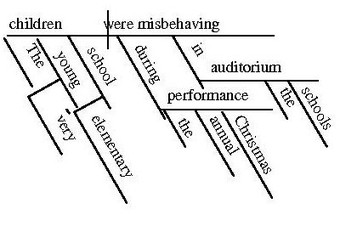
A Sentence Diagram
Human language’s grammatical structure makes it unique.
Written language is the representation of a language by means of a writing system. Written language exists only as a complement to a specific spoken language. Written languages use visual symbols to represent the sounds of the spoken languages, but they still require syntactic rules that govern the production of meaning from sequences of words.
A sign language is a language which, instead of acoustically conveying sound patterns, uses manual communication and body language to convey meaning. This can involve simultaneously combining hand shapes; orientation and movement of the hands, arms or body; and facial expressions to fluidly express a speaker’s thoughts. Sign languages, like spoken languages, organize elementary units into meaningful semantic units.
3.2.6: Gestures
A gesture is a form of non-verbal communication in which visible bodily actions communicate particular messages.
Learning Objective
Explain the role of gestures in the communication process
Key Points
- Gestures allow individuals to communicate a variety of feelings and thoughts, from contempt and hostility to approval and affection, often together with body language in addition to spoken words.
- The most familiar categories of gestures are the so-called emblems or quotable gestures. These are conventional, culture-specific gestures that can be used as replacement for words, such as the handwave used in the U.S. for “hello” and “goodbye”.
- Another broad category of gestures comprises those gestures used spontaneously when we speak. These gestures are closely coordinated with speech.
- Gestural languages such as American Sign Language and its regional siblings operate as complete natural languages that are gestural in modality.
- Gesturing is probably universal; there have been no reports of communities that do not gesture. Gestures are a crucial part of everyday conversation such as chatting, describing a route, or negotiating prices on a market.
Key Terms
- gestural languages
-
A gestural language is a language which, instead of acoustically conveyed sound patterns, uses manual communication and body language to convey meaning. This can involve simultaneously combining hand shapes, orientation and movement of the hands, arms or body, and facial expressions to fluidly express a speaker’s thoughts.
- gesture
-
A motion of the limbs or body, especially one made to emphasize speech.
- quotable gestures
-
Quotable gestures are conventional, culture-specific gestures that can be used as replacement for words.
Example
- Gestures are culturally specific. For example, the quotable gesture for “come along” varies among cultures. In the United States, the gesture is made with the arm outstretched, palm facing up. The gesturer then bends the arm up at the elbow and curls the fingers toward the body. In China, however, the gesture is made differently. The arm is dropped to the side, only slightly outstretched, with the palm facing down and fingers dangling. The gesturer then waves the fingers in toward the body.
A gesture is a form of non-verbal communication in which visible bodily actions communicate particular messages, either in place of speech or together and in parallel with spoken words. Gestures include movement of the hands, face, or other parts of the body. Gestures differ from physical non-verbal communication that does not communicate specific messages, such as purely expressive displays, proxemics, or displays of joint attention. Gestures allow individuals to communicate a variety of feelings and thoughts, from contempt and hostility to approval and affection, often together with body language in addition to spoken words.
The most familiar categories of gestures are the so-called emblems or quotable gestures. These are conventional, culture-specific gestures that can be used as replacement for words, such as the handwave used in the U.S. for “hello” and “goodbye. ” Another broad category of gestures comprises those gestures used spontaneously when we speak. These gestures are closely coordinated with speech. Gestural languages such as American Sign Language and its regional siblings operate as complete natural languages that are gestural .

Gestural Language
American Sign Language, or ASL, is a gestural language. This is how to sign the letters A-S-L.
Many animals, including humans, use gestures to initiate a mating ritual. This may include elaborate dances and other movements. Gestures play a major role in many aspects of human life. Gesturing is probably universal; there have been no reports of communities that do not gesture. Gestures are a crucial part of everyday conversation such as chatting, describing a route, or negotiating prices on a market; they are ubiquitous. Gestures have been documented in the arts such as in Greek vase paintings, Indian Miniatures, and European paintings.

Hand Gestures
Military air marshallers use hand and body gestures to direct flight operations aboard aircraft carriers.
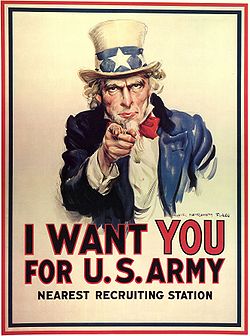
Pointing
Pointing at another person with an extended finger is considered rude in many cultures.
3.2.7: Values
Cultures have values that are largely shared by their members, which identify what should be judged as good or evil.
Learning Objective
Contrast values and norms
Key Points
- The values of a society can often be identified by noting which people receive honor or respect.
- Values are related to the norms of a culture, but they are more global and abstract than norms.
- Norms are rules for behavior in specific situations, while values identify what should be judged as good or evil.
- Members take part in a culture even if each member’s personal values do not entirely agree with some of the normative values sanctioned in the culture.
- Values clarification is helping people clarify what their lives are for and what is worth working for.
- Cognitive moral education is based on the belief that students should learn to value things like democracy and justice as their moral reasoning develops.
Key Terms
- subculture
-
A portion of a culture distinguished from the larger society around it by its customs or other features.
- culture
-
The beliefs, values, behavior, and material objects that constitute a people’s way of life.
- norm
-
A rule that is enforced by members of a community.
Example
- Values are general principles or ideals upheld by a society. For example, in the United States, hard work and independence are fundamental values.
Values can be defined as broad preferences concerning appropriate courses of action or outcomes. Values reflect a person’s sense of right and wrong, or what “ought” to be. Some examples of values are the concepts of “equal rights for all,” “excellence deserves admiration,” and “people should be treated with respect and dignity. ” Values tend to influence attitudes and behavior.
Cultures have values that are largely shared by their members. Different cultures reflect different values. Noting which people receive honor or respect can provide clues to the values of a society. In the US, for example, some professional athletes are honored (in the form of monetary payment) more than college professors.
Values are related to the norms of a culture, but they are more global and abstract than norms. Norms are rules for behavior in specific situations, while values identify what should be judged as good or evil. Flying the national flag on a holiday is a norm, but it reflects the value of patriotism. Wearing dark clothing and appearing solemn are normative behaviors at a funeral; in certain cultures, this reflects the values of respect for and support of friends and family. Different cultures reflect different values.
Members take part in a culture even if each member’s personal values do not entirely agree with some of the normative values sanctioned in the culture. This reflects an individual’s ability to synthesize and extract aspects valuable to them from the multiple subcultures to which they belong. If a group member expresses a value that is in serious conflict with the group’s norms, the group’s authority may encourage conformity or stigmatize the non-conforming behavior of its members .

Punk
Punk social groups are often considered marginal and are excluded from certain mainstream social spaces.

Declaration of Independence
Independence and freedom are fundamental values in the U.S.

Punks as non-conformists
Members of the punk movement refused to conform to some of the normative values prevalent in Western culture.

The Liberty Bell
Many consider liberty to be a fundamental American value.
3.2.8: Norms
Social norms are the explicit or implicit rules specifying what behaviors are acceptable within a society or group.
Learning Objective
Explain the origin, reinforcement, and significance of social norms in a society or group
Key Points
- Norms can be defined as the shared ways of thinking, feeling, desiring, deciding, and acting which are observable in regularly repeated behaviours and are adopted because they are assumed to solve problems.
- Social norms are neither static nor universal; they change with respect to time and vary with respect to culture, social classes, and social groups.
- Social norms can be enforced formally (e.g., through sanctions) or informally (e.g., through body language and non-verbal communication cues).
- One form of norm adoption is the formal method, where norms are written down and formally adopted. However, social norms are more likely to be informal and emerge gradually (e.g., not wearing socks with sandals).
Key Terms
- social norms
-
Social norms are described by sociologists as being laws that govern society’s behaviors.
- social group
-
A collection of humans or animals that share certain characteristics, interact with one another, accept expectations and obligations as members of the group, and share a common identity.
- social classes
-
Social class (or simply “class”) is a set of concepts in the social sciences and political theory centered on models of social stratification in which people are grouped into a set of hierarchical social categories.
Examples
- An example of an explicit social norm is a law, such as a law that prohibits alcohol use by anyone under the age of 21. Explicit norms are often enforced by formal sanctions. In this case, the formal sanction may be a fine or jail time.
- An implicit social norm is an expectation that, though unstated, is commonly accepted by members of a group. An example is the use of deoderant. People are not required to wear deoderant, but most people in the United States expect others to do so and do so themselves. Implicit norms are usually enforced by informal sanctions. In this case, informal sanctions might include dirty looks or avoidance.
Social norms are the explicit or implicit rules specifying acceptable behaviors within a society or group. They define the expected or acceptable behavior in particular circumstances. Social norms can also be defined as the shared ways of thinking, feeling, desiring, deciding, and acting which are observable in regularly repeated behaviors and are adopted because they are assumed to solve problems.
Social norms are neither static nor universal; they change with respect to time and vary with respect to culture, social classes, and social groups. What is deemed acceptable dress, speech, or behavior in one social group may not be acceptable in another.
Deference to social norms maintains one’s acceptance and popularity within a particular group. Social norms can be enforced formally (e.g., through sanctions) or informally (e.g., through body language and non-verbal communication cues) . By ignoring or breaking social norms, one risks facing formal sanctions or quiet disapproval, finding oneself unpopular with or ostracized from a group.

Formal Sanctions
Norms may be enforced through informal sanctions, such as derision, or formal sanctions, such as arrest.
As social beings, individuals learn when and where it is appropriate to say certain things, use certain words, discuss certain topics, or wear certain clothes, and when it is not. Groups may adopt norms in two different ways. One form of norm adoption is the formal method, where norms are written down and formally adopted (e.g., laws, legislation, club rules). Social norms are much more likely to be informal and to emerge gradually (e.g., not wearing socks with sandals) .
Groups internalize norms by accepting them as reasonable and proper standards for behavior within the group. That said, while it is more likely that a new individual entering a group will adopt the group’s norms, values, and perspectives, newcomers to a group can also change a group’s norms.

Same-Sex Marriage and Social Norms
In most Western countries, norms have prohibited same-sex marriage, but those norms are now changing.
3.2.9: Sanctions
As opposed to forms of internal control, like norms and values, sociologists consider sanctions a form of external control.
Learning Objective
Differentiate between methods of formal and informal social control
Key Points
- Sanctions can either be positive (rewards) or negative (punishment).
- Sanctions can arise from either formal or informal control.
- With informal sanctions, ridicule or ostracism can realign a straying individual towards norms. Informal sanctions may include shame, ridicule, sarcasm, criticism, and disapproval.
- Groups, organizations, and societies of various kinds can promulgate rules that act as formal sanctions to reward or punish behavior. For example, government and organizations use law enforcement mechanisms and other formal sanctions such as fines and imprisonment.
- To maintain control and regulate their subjects, authoritarian organizations and governments use severe sanctions such as censorship, expulsion, and limits on political freedom.
Key Terms
- Informal sanctions
-
These are the reactions of individuals and groups that bring about conformity to norms and laws. These can include peer and community pressure, bystander intervention in a crime, and collective responses such as citizen patrol groups.
- sanction
-
a penalty, or some coercive measure, intended to ensure compliance; especially one adopted by several nations, or by an international body
- social control
-
any control, either formal or informal, that is exerted by a group, especially by one’s peers
Example
- Internal controls are a form of social control that we impose on ourselves. For example, you may choose to wear nice clothes to class instead of pajamas, not because there is a rule against pajamas or because anyone has directly exercised social sanctions against you, but because you have internalized the norm of dressing when you leave home.
Sanctions
Sanctions are mechanisms of social control. As opposed to forms of internal control, like cultural norms and values, sociologists consider sanctions a form of external control. Sanctions can either be positive (rewards) or negative (punishment), and can arise from either formal or informal control .
Informal Social Control and Deviance
The social values present in individuals are products of informal social control. This type of control emerges from society, but is rarely stated explicitly to individuals. Instead, it is expressed and transmitted indirectly, through customs, norms and mores. Whether consciously or not, individuals are socialized. With informal sanctions, ridicule or ostracism can cause a straying individual to realign behavior toward group norms. Informal sanctions may include shame, ridicule, sarcasm, criticism, and disapproval. In extreme cases, sanctions may include social discrimination and exclusion. If a young boy is caught skipping school, and his peers ostracize him for his deviant behavior, they are exercising an informal sanction on him. Informal sanctions can check deviant behavior of individuals or groups, either through internalization, or through disincentivizing the deviant behavior.
As with formal controls, informal controls reward or punish acceptable or unacceptable behavior, otherwise known as deviance. Informal controls are varied and differ from individual to individual, group to group, and society to society. To maintain control and regulate their subjects, groups, organizations, and societies of various kinds can promulgate rules that act as formal sanctions to reward or punish behavior. For example, in order to regulate behavior, government and organizations use law enforcement mechanisms and other formal sanctions such as fines and imprisonment . Authoritarian organizations and governments may rely on more directly aggressive sanctions. These actions might include censorship, expulsion, restrictions on political freedom, or violence. Typically, these more extreme sanctions emerge in situations where the public disapproves of either the government or organization in question.

A Prison Cell Block
Incarceration is a type of formal sanction.

Shame
Shame can be used as a type of informal sanction.
3.2.10: Folkways and Mores
Folkways and mores are informal norms that dictate behavior; however, the violation of mores carries heavier consequences.
Learning Objective
Differentiate between folkways and mores
Key Points
- Societal norms, or rules that are enforced by members of a community, can exist as both formal and informal rules of behavior. Informal norms can be divided into two distinct groups: folkways and mores.
- Both “mores” and “folkways” are terms coined by the American sociologist William Graham Sumner.
- Mores distinguish the difference between right and wrong, while folkways draw a line between right and rude. While folkways may raise an eyebrow if violated, mores dictate morality and come with heavy consequences.
Key Terms
- William Graham Sumner
-
An American academic with numerous books and essays on American history, economic history, political theory, sociology, and anthropology.
- mores
-
A set of moral norms or customs derived from generally accepted practices. Mores derive from the established practices of a society rather than its written laws.
- folkway
-
A custom or belief common to members of a society or culture.
Example
- Different regions of the United States have different folkways that govern how people greet one another. In many rural regions, people crossing paths in the street nod and say “hello” or “how are you? ” Drivers meeting one another on remote country roads give each other a quick wave. But in most urban regions, neither walkers nor drivers acknowledge one another unless provoked. Urban residents who travel to remote places may notice the difference and find the folkways unusual. The local residents may find the urban newcomers strange or a little cold if they do not offer greetings, but they will probably not sanction them formally or informally. Likewise, in the city, residents may think newcomers from the country a bit odd if they give unsolicited greetings, but those greetings will probably not draw sanctions.
Societal norms, or rules that are enforced by members of a community, can exist as both formal and informal rules of behavior. Informal norms can be divided into two distinct groups: folkways and mores. Folkways are informal rules and norms that, while not offensive to violate, are expected to be followed. Mores (pronounced more-rays) are also informal rules that are not written, but, when violated, result in severe punishments and social sanction upon the individuals, such as social and religious exclusions,.
William Graham Sumner , an early U.S. sociologist, recognized that some norms are more important to our lives than others. Sumner coined the term mores to refer to norms that are widely observed and have great moral significance. Mores are often seen as taboos; for example, most societies hold the more that adults not engage in sexual relations with children. Mores emphasize morality through right and wrong, and come with heavy consequences if violated.
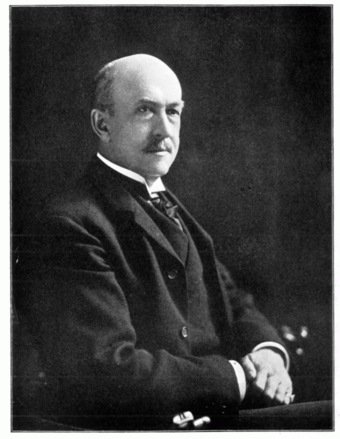
William Graham Sumner, 1840-1910
William Graham Sumner coined the terms “folkways” and “mores. “
Sumner also coined the term folkway to refer to norms for more routine or casual interaction. This includes ideas about appropriate greetings and proper dress in different situations. In comparison to the morality of mores, folkways dictate what could be considered either polite or rude behavior. Their violation does not invite any punishment or sanctions, but may come with reprimands or warnings.
An example to distinguish the two: a man who does not wear a tie to a formal dinner party may raise eyebrows for violating folkways; were he to arrive wearing only a tie, he would violate cultural mores and invite a more serious response.
3.3: Culture and Adaptation
3.3.1: The Origins of Culture
Culture is a central concept in anthropology, encompassing the range of human phenomena that cannot be attributed to genetic inheritance.
Learning Objective
Paraphrase what is currently thought to be the reason for the development of language and complex culture
Key Points
- The term “culture” has two meanings: (1) the evolved human capacity to classify and represent experiences with symbols, and to act creatively; and (2) the distinct ways that people living in different parts of the world acted creatively and classified or represented their experiences.
- Distinctions are currently made between the physical artifacts created by a society, its so-called material culture and everything else, including the intangibles such as language, customs, etc. that are the main referent of the term “culture”.
- The origin of language, understood as the human capacity of complex symbolic communication, and the origin of complex culture are often thought to stem from the same evolutionary process in early man.
- Language and culture both emerged as a means of using symbols to construct social identity and maintain coherence within a social group too large to rely exclusively on the pre-human ways of building community (for example, grooming).
Key Terms
- community
-
A group sharing a common understanding and often the same language, manners, tradition and law. See civilization.
- horticulture
-
The art or science of cultivating gardens; gardening.
Example
- Adaptation is necessary for our continued survival, but biological adaptation can be slow. Culture allows humans to more quickly adapt. For example, humans face dangers from food-born illnesses, such as trichinosis from pork. A biologically adaptive strategy could emerge over many generations if humans developed immunity to trichinosis, but a culturally adaptive strategy could emerge more quickly if a group of people enforced a norm against eating pork.
Culture (Latin: cultura, lit. “cultivation”) is a modern concept based on a term first used in classical antiquity by the Roman orator, Cicero: “cultura animi. ” The term “culture” appeared first in its current sense in Europe in the 18th and 19th centuries, to connote a process of cultivation or improvement, as in agriculture or horticulture. In the 19th century, the term developed to refer first to the betterment or refinement of the individual, especially through education, and then to the fulfillment of national aspirations or ideals. In the mid-19th century, some scientists used the term “culture” to refer to a universal human capacity.
In the 20th century, “culture” emerged as a central concept in anthropology, encompassing the range of human phenomena that cannot be attributed to genetic inheritance. Specifically, the term “culture” in American anthropology had two meanings: (1) the evolved human capacity to classify and represent experiences with symbols, and to act imaginatively and creatively; and (2) the distinct ways that people living in different parts of the world acted creatively and classified or represented their experiences. Distinctions are currently made between the physical artifacts created by a society, its so-called material culture and everything else, including the intangibles such as language, customs, etc. that are the main referent of the term “culture. “
The origin of language, understood as the human capacity of complex symbolic communication, and the origin of complex culture are often thought to stem from the same evolutionary process in early man. Evolutionary anthropologist Robin I. Dunbar has proposed that language evolved as early humans began to live in large communities that required the use of complex communication to maintain social coherence. Language and culture then both emerged as a means of using symbols to construct social identity and maintain coherence within a social group too large to rely exclusively on pre-human ways of building community (for example, grooming).
However, languages, now understood as the particular set of speech norms of a particular community, are also a part of the larger culture of the community that speak them. Humans use language as a way of signalling identity with one cultural group and difference from others. Even among speakers of one language, several different ways of using the language exist, and each is used to signal affiliation with particular subgroups within a larger culture.

Nomads
Anthropologists rejected the idea that culture was unique to Western society and adopted a new definition of culture that applied to all societies, literate and non-literate, settled and nomadic.
3.3.2: Mechanisms of Cultural Change
The belief that culture can be passed from one person to another means that cultures, although bounded, can change.
Learning Objective
Describe at least two mechanisms which foster cultural change
Key Points
- Cultures are internally affected by both forces encouraging change and forces resisting change. These forces are related to social structures and natural events, and are involved in the perpetuation of cultural ideas and practices within current structures, which are themselves subject to change.
- Cultural change can have many causes, including the environment, technological inventions, and contact with other cultures.
- In diffusion, the form of something (though not necessarily its meaning) moves from one culture to another.
- Acculturation has different meanings, but in this context it refers to replacement of the traits of one culture with those of another, such has happened to certain Native American tribes and to many indigenous peoples across the globe during the process of colonization.
- “Direct Borrowing” on the other hand tends to refer to technological or tangible diffusion from one culture to another.
- Griswold suggests that culture changes through the contextually dependent and socially situated actions of individuals; macro-level culture influences the individual who, in turn, can influence that same culture.
- In anthropology, diffusion theory states that the form of something moves from one culture to another, but not its meaning. Acculturation theory refers to replacement of the traits of one culture with those of another.
Key Terms
- habit
-
An action performed repeatedly and automatically, usually without awareness.
- assimilation
-
The adoption, by a minority group, of the customs and attitudes of the dominant culture.
Example
- An invention that substantially changed culture was the development of the birth control pill, which changed women’s attitudes toward sex. Prior to the introduction of the birth control pill, women were at a high risk of pregnancy as a result of sex. After the introduction of the pill, their risk of pregnancy was substantially reduced, increasing their willingness to engage in sexual activity outside of wedlock.
Fundamentally, although bounded, cultures can change. Cultures are internally affected by both forces encouraging change and forces resisting change. These forces are related to social structures and natural events, and are involved in the perpetuation of cultural ideas and practices within current structures, which are themselves subject to change . Resistance can come from habit, religion, and the integration and interdependence of cultural traits. For example, men and women have complementary roles in many cultures. One sex might desire changes that affect the other, as happened in the second half of the 20th century in western cultures (see, for example, the women’s movement), while the other sex may be resistant to that change (possibly in order to maintain a power imbalance in their favor).

Biology versus Culture
These two avatars illustrate the basic concept of culture. One is simply a reflection of his biology; he is human. The other is a reflection of his biology and his culture: he is human and belongs to a cultural group or sub-culture.
Cultural change can have many causes, including the environment, technological inventions, and contact with other cultures. Cultures are externally affected via contact between societies, which may also produce—or inhibit—social shifts and changes in cultural practices. War or competition over resources may impact technological development or social dynamics. Additionally, cultural ideas may transfer from one society to another, through diffusion or acculturation.
Discovery and invention are mechanisms of social and cultural change. Discovery refers to the finding of new knowledge within an existing realm. Generally, it relates to discovering new understanding of a particular behavior or ritual. Invention is the creation of a new device or process. New discoveries often lead to new inventions by people.
In diffusion, the form of something (though not necessarily its meaning) moves from one culture to another. For example, hamburgers, mundane in the United States, seemed exotic when introduced into China. “Stimulus diffusion” (the sharing of ideas) refers to an element of one culture leading to an invention or propagation in another .

The Change of Symbolic Meaning Over Time
The symbol of the ankh has its roots in Egyptian religious practice, but the symbol diffused over time and was adopted by other groups, including pagans, as a religious symbol.
Acculturation has different meanings, but in this context it refers to replacement of the traits of one culture with those of another, such has happened to certain Native American tribes and to many indigenous peoples across the globe during the process of colonization. Related processes on an individual level include assimilation (adoption of a different culture by an individual) and transculturation.
3.3.3: Cultural Lag
The term “cultural lag” refers to the fact that culture takes time to catch up with technological innovations, resulting in social problems.
Learning Objective
Produce an example of cultural lag using an example of the tension between material and non-material culture
Key Points
- Cultural lag is not only a concept, as it also relates to a theory and explanation in sociology.
- It helps identify and explain social problems and also predict future problems.
- According to Ogburn, cultural lag is a common societal phenomenon due to the tendency of material culture to evolve and change rapidly and voluminously while non-material culture tends to resist change and remain fixed for a far longer period of time.
- Due to the opposing nature of these two aspects of culture, adaptation of new technology becomes rather difficult.
Key Terms
- non-material culture
-
In contrast to material culture, non-material culture does not include any physical objects or artifacts. Examples of non-material culture include any ideas, beliefs, values, and norms that may help shape our society.
- material culture
-
In the social sciences, material culture is a term, developed in the late 19th and early 20th century, that refers to the relationship between artifacts and social relations.
- innovation
-
The act of innovating; the introduction of something new, in customs, rites, and so on.
Example
- Cultural lag can occur when technological innovation outpaces cultural adaptation. For example, when cars were first invented, there were not yet any laws to govern driving: no speed limits, no guidelines for who had the right of way at intersections, no lane markers, no stop signs, and so on. As you can imagine, the result was chaos. City streets became incredibly dangerous. Laws soon were written to address this problem, closing the gap.
The term cultural lag refers to the notion that culture takes time to catch up with technological innovations, and that social problems and conflicts are caused by this lag. Cultural lag is not only a concept, as it also relates to a theory and explanation in sociology. Cultural lag helps to identify and explain social problems and to predict future problems.
The term was coined by the sociologist William F. Ogburn in his 1922 work “Social Change with Respect to Culture and Original Nature. ” According to Ogburn, cultural lag is a common societal phenomenon due to the tendency of material culture to evolve and change rapidly while non-material culture tends to resist change and remain fixed for a far longer period of time. His theory of cultural lag suggests that a period of maladjustment occurs when the non-material culture is struggling to adapt to new material conditions.
Due to the opposing nature of these two aspects of culture, adaptation of new technology becomes rather difficult. As explained by James W. Woodward, when material conditions change, changes are felt in the non-material culture as well. But these changes in the non-material culture do not match exactly with the change in the material culture. This delay is the cultural lag.
Cultural lag creates problems for a society in different ways. Cultural lag is seen as a critical ethical issue because failure to develop broad social consensus on appropriate uses of modern technology may lead to breakdowns in social solidarity and the rise of social conflict . The issue of cultural lag tends to permeate any discussion in which the implementation of some new technology can become controversial for society at large.

Human Embryonic Stem Cells
As example of cultural lag is human embryonic stem cells. We have the necessary technology to turn stem cells into neurons but have not yet developed ethical guidelines and cultural consensus on this practice.
3.3.4: Animals and Culture
Animal culture refers to cultural learning in non-human animals through socially transmitted behaviors.
Learning Objective
Formulate a thesis which defends the idea that non-human animals have culture
Key Points
- Much cultural anthropological research has been done on non-human primates, due to their close evolutionary proximity to humans.
- One of the first signs of culture in early humans was the use of tools. Chimpanzees have been observed using tools such as rocks and sticks to obtain better access to food.
- The acquisition and sharing of behaviors correlates directly to the existence of memes, which are defined as “units of cultural transmission” by the evolutionary biologist Richard Dawkins.
- Though the idea of culture in animals has only been around for just over half of a century, scientists have been noting social behaviors of animals for centuries.
- Aristotle was the first to provide evidence of social learning in the bird songs. Charles Darwin first attempted to find the existence of imitation in animals when trying to prove his theory that the human mind had evolved from that of lower beings.
Key Terms
- meme
-
Any unit of cultural information, such as a practice or idea, that is transmitted verbally or by repeated action from one mind to another.
- social behaviors
-
In physiology and sociology, social behavior is behavior directed towards society, or taking place between, members of the same species.
- cultural anthropological research
-
Cultural anthropology is a branch of anthropology focused on the study of cultural variation among humans, collecting data about the impact of global economic and political processes on local cultural realities.
Animal culture refers to cultural learning in non-human animals through socially transmitted behaviors. The question of the existence of culture in non-human societies has been a contentious subject for decades due to the inexistence of a concise definition for culture. However, many scientists agree on culture being defined as a process, rather than an end product. This process, most agree, involves the social transmission of a novel behavior, both among peers and between generations. This behavior is shared by a group of animals, but not necessarily between separate groups of the same species .

Animal Culture
A chimpanzee mother and baby.
Tools and Learned Activities
One of the first signs of culture in early humans was the use of tools. Chimpanzees have been observed using tools such as rocks and sticks to obtain better access to food. There are other learned activities that have been exhibited by animals as well. Some examples of these activities that have been shown by varied animals are opening oysters, swimming, washing food, and unsealing tin lids. The acquisition and sharing of behaviors correlates directly to the existence of memes, which are defined as “units of cultural transmission” by the evolutionary biologist Richard Dawkins. It especially reinforces the natural selection component. These learned actions are mechanisms for making life easier, and therefore longer.
History of Animal Culture
Though the idea of culture in animals has only been around for just over half of a century, scientists have been noting social behaviors of animals for centuries. Aristotle was the first to provide evidence of social learning in the bird songs. Charles Darwin first attempted to find the existence of imitation in animals when trying to prove his theory that the human mind had evolved from that of lower beings. Darwin was also the first to suggest what became known as ‘social learning’ in explaining the transmission of an adaptive behavior pattern throughout a population of honey bees.
Much cultural anthropological research has been done on non-human primates, due to their close evolutionary proximity to humans. In non-primate animals, research tends to be limited, so the evidence for culture is lacking. The subject has become more popular recently, prompting more research in the field.
3.4: Culture Worlds
3.4.1: Subcultures
A subculture is a culture shared and actively participated in by a minority of people within a broader culture.
Learning Objective
Give examples for subcultures by using Gelder’s proposed criteria
Key Points
- Subcultures incorporate large parts of the broader cultures of which they are part; in specifics they may differ radically.
- The study of subcultures often consists of the study of symbolism attached to clothing, music, and other visible affectations by members of subcultures. Sociologists also study the ways in which these same symbols are interpreted by members of the dominant culture.
- Cultural appropriation is the process by which businesses often seek to capitalize on the subversive allure of subcultures in search of “cool,” which remains valuable in the selling of any product.
Key Terms
- cultural appropriation
-
Cultural appropriation is the adoption of some specific elements of one culture by a different cultural group.
- subculture
-
A portion of a culture distinguished from the larger society around it by its customs or other features.
- symbolism
-
Representation of a concept through symbols or underlying meanings of objects or qualities.
Example
- Religious minorities could be considered subcultures. For example, Mormons might be considered a subculture. Within Mormon culture, there may be yet more subcultures (or sub-subcultures), such as those who continue to practice polygamy.
In sociology, anthropology, and cultural studies, a subculture is a group of people with a culture that differentiates themselves from the larger culture to which they belong. A culture often contains numerous subcultures, which incorporate large parts of the broader cultures of which they are part; in specifics they may differ radically. Subcultures bring together like-minded individuals who feel neglected by societal standards and allow them to develop a sense of identity.
Subcultures and Symbolism
The study of subcultures often consists of the study of symbolism attached to clothing, music, and other visible affectations by members of subcultures. Additionally, sociologists study the ways in which these symbols are interpreted by members of the dominant culture. Some subcultures achieve such a status that they acquire a name. Members of a subculture often signal their membership through a distinctive and symbolic use of style, which includes fashions, mannerisms, and argot. Examples of subcultures could include bikers, military personel, and Star Trek fans .

Trekkies
The hand gesture meaning ‘live long and prosper’ has spread beyond the subculture of Star Trek fans and is often recognized in mainstream culture.
Identifying Subcultures
It may be difficult to identify certain subcultures because their style—particularly clothing and music—may be adopted by mass culture for commercial purposes. Businesses often seek to capitalize on the subversive allure of subcultures in search of “cool,” which remains valuable in selling of any product. This process of cultural appropriation may often result in the death or evolution of the subculture, as its members adopt new styles that appear alien to mainstream society.
In 2007, Ken Gelder proposed six key ways in which subcultures can be identified:
- Through their often negative relations to work (as ‘idle’, ‘parasitic’, at play or at leisure, etc.)
- Through their negative or ambivalent relation to class (since subcultures are not ‘class-conscious’ and don’t conform to traditional class definitions)
- Through their association with territory (the ‘street’, the ‘hood’, the club, etc.), rather than property
- Through their movement out of the home and into non-domestic forms of belonging (i.e. social groups other than the family)
- Through their stylistic ties to excess and exaggeration (with some exceptions)
- Through their refusal of the banalities of ordinary life
3.4.2: Countercultures
Counterculture is a term describing the values and norms of a cultural group that run counter to those of the social mainstream of the day.
Learning Objective
Apply the concept of counterculture to the rise and collapse of the US Hippie movement
Key Points
- Examples of countercultures in the U.S. could include the hippie movement of the 1960s, the green movement, polygamists, and feminist groups.
- A counterculture is a subculture with the specific characteristic that some of its beliefs, values, or norms challenge or even contradict those of the main culture with which it shares a geographic region and/or origin.
- Countercultures run counter to dominant cultures and the social mainstream of the day.
Key Terms
- counterculture
-
Any culture whose values and lifestyles are opposed to those of the established mainstream culture, especially to western culture.
- culture
-
The beliefs, values, behavior, and material objects that constitute a people’s way of life.
- mainstream
-
Purchased, used, or accepted broadly rather than by a tiny fraction of a population or market; common, usual, or conventional.
Example
- Modern American Marxist political groups are examples of countercultures — they promote a worldview and set of norms and values that are contrary to the dominant American system.
“Counterculture” is a sociological term that refers to a cultural group or subculture whose values and norms of behavior run counter to those of the region’s social mainstream; it can be considered the cultural equivalent of political opposition.
In the United States, the counterculture of the 1960s became identified with the rejection of conventional social norms of the 1950s. Counterculture youth rejected the cultural standards of their parents, especially with respect to racial segregation and initial widespread support for the Vietnam War.
As the 1960s progressed, widespread tensions developed in American society that tended to flow along generational lines regarding the war in Vietnam, race relations, sexual mores, women’s rights, traditional modes of authority, and a materialistic interpretation of the American Dream. Hippies became the largest countercultural group in the United States. The counterculture also had access to a media eager to present their concerns to a wider public. Demonstrations for social justice created far-reaching changes affecting many aspects of society .

Hippies at an Anti-Vietnam Demonstration, 1967
A female demonstrator offers a flower to military police on guard at the Pentagon during an anti-Vietnam demonstration.
The counterculture in the United States lasted from roughly 1964 to 1973 — coinciding with America’s involvement in Vietnam — and reached its peak in 1967, the “Summer of Love. ” The movement divided the country: to some Americans, these attributes reflected American ideals of free speech, equality, world peace, and the pursuit of happiness; to others, the same attributes reflected a self-indulgent, pointlessly rebellious, unpatriotic, and destructive assault on America’s traditional moral order.
The counterculture collapsed circa 1973, and many have attributed its collapse to two major reasons: First, the most popular of its political goals — civil rights, civil liberties, gender equality, environmentalism, and the end of the Vietnam War — were accomplished. Second, a decline of idealism and hedonism occurred as many notable counterculture figures died, the rest settled into mainstream society and started their own families, and the “magic economy” of the 1960s gave way to the stagflation of the 1970s.
3.5: Culture and the Dominant Ideology in the U.S.
3.5.1: An Overview of U.S. Values
Despite certain consistent values (e.g. individualism, egalitarianism, freedom, democracy), American culture has a variety of expressions.
Learning Objective
Defend the notion that America has both consistent values and a variety of expressions
Key Points
- Values are related to the norms of a culture, but they are more global and abstract than norms. Norms are rules for behavior in specific situations, while values identify what should be judged as good or evil.
- American culture includes both conservative and liberal elements, scientific and religious competitiveness, political structures, risk taking and free expression, materialist and moral elements.
- American culture has a variety of expressions due to its geographical scale and demographic diversity.
- Since the late 1970’s, the term “traditional values” has become synonymous with “family values” in the U.S., and implies a congruence with mainstream Christianity. However “family values” is arguably a modern politicized subset of traditional values, which is a larger concept.
Key Terms
- conservative
-
A person who favors maintenance of the status quo or reversion to some earlier status.
- liberal
-
Open to political or social changes and reforms associated with either classical or modern liberalism.
- traditional
-
Of or pertaining to tradition; derived from tradition; communicated from ancestors to descendants by word only; transmitted from age to age without writing; as, traditional opinions; traditional customs; traditional expositions of the Scriptures.
Example
- Achievement and success are typical American values. These values may explain why so many Americans pursue higher education in order to get better jobs and earn more money, as well as why Americans are given so few vacation days compared to other countries.
Cultures have values that are largely shared by their members. The values of a society can often be identified by noting that which people receive, honor or respect.
Values are related to the norms of a culture, but they are more global and abstract than norms. Norms are rules for behavior in specific situations, while values identify what should be judged as either good or evil. Flying the national flag on a holiday is a norm, but it reflects the value of patriotism. Wearing dark clothing and appearing solemn are normative behaviors at a funeral; in certain cultures, they reflect the values of respect and support for friends and family.

The Statue of Liberty
The Statue of Liberty symbolizes freedom, a fundamental American value.
Different cultures reflect different values. American culture includes both conservative and liberal elements, such as scientific and religious competitiveness, political structures, risk taking and free expression, materialist and moral elements. Aside from certain consistent ideological principles (e.g. individualism, egalitarianism and faith in freedom and democracy), American culture’s geographical scale and demographic diversity has spawned a variety of expressions. The flexibility of U.S. culture and its highly symbolic nature lead some researchers to categorize American culture as a mythic identity, while others recognize it as American exceptionalism.

Declaration of Independence
Many fundamental American values are derived from the Declaration of Independence.
Since the late 1970’s, the terms “traditional values” and”family values” have become synonymous in the U.S., and imply a congruence with mainstream Christianity . However, the term “family values” is arguably a modern politicized subset of traditional values, which is a larger concept, anthropologically speaking. Although It is also not necessarily a political idea, it has become associated with both the particular correlation between Evangelicalism and politics (as embodied by American politicians such as Ronald Reagan, Dan Quayle and George W. Bush), as well as the broader Christianity movement (as exemplified by Pat Robertson).

Traditional values as “family values”?
“Family values” is arguably a modern politicized subset of traditional values.
3.5.2: Value Clusters
People from different backgrounds tend to have different value systems, which cluster together into a more or less consistent system.
Learning Objective
Evaluate the separation of world values into the categories of ‘self-expression’ and ‘survival’
Key Points
- The World Values Survey is used to identify different clusters of values around the world.
- Traditional and survival values tend to cluster in developing countries.
- With industrialization, countries shift from traditional to secular values.
- With the rise of knowledge economies, countries tend to shift from survival to self-expression values.
- With the rise of knowledge economies, countries tend to shift from survival to self-expression values.
Key Terms
- Traditional Values
-
Traditional values emphasize the importance of religion, parent-child ties, deference to authority and traditional family values. People who embrace these values also reject divorce, abortion, euthanasia, and suicide. These societies have high levels of national pride and a nationalistic outlook.
- Secular Values
-
Secular values, as opposed to traditional values, base morality on human faculties such as logic, reason, or moral intuition, rather than on purported supernatural revelation or guidance (which is the source of religious ethics).
Example
- In the 1970s, the United States economy underwent a major shift. Before the 1970s, most people worked in manufacturing. After the 1970s, more people worked in the service sector, and the knowledge economy took off. With this economic shift, values began to change, too. For example, the 1970s saw the blossoming of the environmental movement, which put less emphasis on survival values. Rather than focusing on putting enough food on the table, people became concerned with how that food was produced, packaged, and transported. They began to make consumption decisions based on self-expression; they bought organic produce or free range beef to express their belief that sustainability and environmental protection mattered.
People from different backgrounds tend to have different sets of values, or value systems. Certain values may cluster together into a more or less consistent system. A communal or cultural value system is held by and applied to a community, group, or society. Some communal value systems are reflected in legal codes and laws.
World Values Survey
Some sociologists are interested in better defining and measuring value clusters in different countries. To do so, they have developed what is called the World Values Survey, a survey of questions given to people around the world and used to identify different clusters of values in different regions. Over the years, the World Values Survey has demonstrated that people’s beliefs play a key role in defining life in different countries—defining anything from a nation’s economic development to the emergence of democratic institutions to the rise of gender equality .

World Values Survey
The World Values Survey is administered to people around the world. Their responses are aggregated and can be used to reveal regional value clusters, like those displayed in this map.
Trends
In general, the World Values Survey has revealed two major axes along which values cluster: (1) a continuum from traditional to secular values and (2) a continuum from survival to self-expression. Traditional values emphasize the importance of religion, parent-child ties, deference to authority, and traditional family values. People who embrace these values also reject divorce, abortion, euthanasia, and suicide. These societies have high levels of national pride and a nationalistic outlook. Secular values have the opposite preferences to the traditional values. These societies place less emphasis on religion, traditional family values, and authority. Divorce, abortion, euthanasia, and suicide are seen as relatively acceptable. Industrialization tends to bring a shift from traditional values to secular ones.
With the rise of the knowledge society, cultural change moves in a new direction. The transition from industrial society to knowledge society is linked to a shift from survival values to self-expression values. In knowledge societies, such as the United States, an increasing share of the population has grown up taking survival for granted. Survival values place emphasis on economic and physical security. It is linked with a relatively ethnocentric outlook and low levels of trust and tolerance. Self-expression values give high priority to environmental protection; tolerance of foreigners, gays, and lesbians; gender equality; and participation in decision-making as it relates to economic and political life.
3.5.3: Value Contradictions
Although various values often reinforce one another, these clusters of values may also include values that contradict one another.
Learning Objective
Analyze a scenario in which a value system, either individual or collective, is shown to be internally inconsistent, and then resolve the conflict
Key Points
- Value systems may contain value contradictions. A value system by itself is internally inconsistent if its values contradict each other, and its exceptions are highly situational and inconsistently applied.
- Value contradictions can also arise within systems of personal or communal values.
- Often, conflicts arise due to value systems contradictions. Society tries to resolve value contradictions in order to reduce conflict.
- Society tries to resolve value contradictions.
Key Terms
- Value Consistency
-
A value system in its own right is internally consistent when its values do not contradict each other, and its exceptions are abstract enough to be used in all situations and consistently applied.
- Value Contradictions
-
A value system by itself is internally inconsistent or contradictory if its values contradict each other, and its exceptions are highly situational and inconsistently applied.
- Communal Values
-
A communal or cultural value system is held by and applied to a community/ group/society. Some communal value systems are reflected in the form of legal codes or law.
Examples
- An example of conflict would be a value system based on individualism pitted against a value system based on collectivism. Society might try to resolve that conflict in various ways, such as the using the following guideline: Individuals may act freely unless their actions harm others or interfere with others’ freedom or with functions of society that individuals need, provided those functions do not themselves interfere with these prescribed individual rights and were agreed to by a majority of the individuals.
- Individuals may act freely unless their actions harm others or interfere with others’ freedom or with functions of society that individuals need, provided those functions do not themselves interfere with these prescribed individual rights and were agreed to by a majority of the individuals.
- A society (or more specifically the system of order that enables the workings of a society) exists for the purpose of benefiting the lives of the individuals who are members of that society. The functions of a society in providing such benefits would be those agreed to by the majority of individuals in the society.
- A society may require contributions from its members in order for them to benefit from the services provided by the society. The failure of individuals to make such required contributions could be considered a reason to deny those benefits to them, although a society could elect to consider hardship situations in determining how much should be contributed.
- A society may restrict behavior of individuals who are members of the society only for the purpose of performing its designated functions agreed to by the majority of individuals in the society, only insofar as they violate the aforementioned values. This means that a society may abrogate the rights of any of its members who fails to uphold the aforementioned values.
Although value clusters generally work together so that various values reinforce one another, at times, these clusters of values may also include values that contradict one another. Value contradictions can arise between individual and communal value systems. That is, as a member of a society, group, or community, an individual can hold both a personal value system and a communal value system at the same time. In this case, the two value systems (one personal and one communal) are externally consistent provided they bear no contradictions or situational exceptions between them.
Value contradictions can also arise within individual or communal value systems. A value system is internally consistent (value consistency) when its values do not contradict each other and its exceptions are abstract enough to be used in all situations and consistently applied. Conversely, a value system by itself is internally inconsistent if its values contradict each other and its exceptions are highly situational and inconsistently applied. A value contradiction could be based on a difference in how people rank the value of things, or on fundamental value conflict. For example, although sharing a set of common values, such as hockey is better than baseball or ice cream is better than fruit, two different parties might not rank those values equally. Also, two parties might disagree as to whether certain actions are right or wrong, both in theory and in practice, and find themselves in an ideological or physical conflict.
Conflicts are often a result of differing value systems. An example conflict would be a value system based on individualism pitted against a value system based on collectivism. A rational value system organized to resolve the conflict between two such value systems might take this form: Individuals may act freely unless their actions harm others or interfere with others’ freedom or with functions of society that individuals need, provided those functions do not themselves interfere with these proscribed individual rights and were agreed to by a majority of the individuals.

Protestors clash with police at the 1999 WTO summit in Seattle
People whose personal values conflict with communal values may try to change communal values through protest.
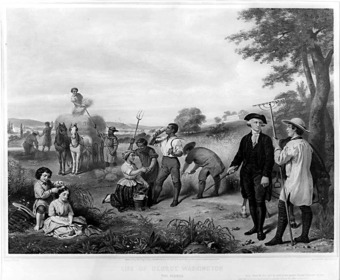
Life of George Washington–The farmer
This picture, by French artist Régnier, shows George Washington standing among African American field workers. The practice of slavery represents a value contradiction between wealth and liberty.
3.5.4: Emerging Values
Values tend to change over time, and the dominant values in a country might shift as that country undergoes economic and social change.
Learning Objective
Criticize materialist values for the sake of argument
Key Points
- Millennials and Baby Boomers grew up under different conditions and therefore have different values.
- People who grow up worrying about meeting their basic material needs will tend to have materialist values that emphasize survival and meeting basic needs.
- People who grow up without having to worry about meeting basic material needs will tend to have post-materialist values such as self-expression.
Key Terms
- values
-
A collection of guiding principles; what one deems to be correct and desirable in life, especially regarding personal conduct.
- autonomy
-
Self-government; freedom to act or function independently.
Example
- The difference between materialist and post-materialist values can often be witnessed in family dinner conversations, which reveal how generational change leads to value change. A father, who grew up with only the bare necessities, may work very hard to provide for his family. He ensures that his children have what he never had: the security of having every basic need and most of their desires satisfied. But his children, growing up with such material security, develop different values. Rather than being concerned with earning a living, they are concerned with making a difference and following their dreams. At family dinners, the father may urge his children to pursue practical courses in college that will prepare them for dependable jobs, whereas the children may argue in favor of pursuing interesting courses that may lack practical application.
Values tend to change over time. The dominant values in a country may shift as that country undergoes economic and social change. Often, such value change can be observed in generational differences. For example, most young adults today share similar values. They are sometimes referred to as Generation Y or Milliennials. This generation was born in the 1980s and 1990s, and raised in a much more technologically advanced environment.

Millennials (Generation Y)
This generation was born in the 1980s and 1990s, a time of major technological advancement.
Milliennials tend to have different values than the previous generation. Some common, notable tendencies are:
- wanting to “make a difference” or have purpose
- wanting to balance work with the rest of life
- excessive seeking of fun and variety
- questioning authority or refusal to respond to authority without “good reason”
- unlimited ambition coupled with overly demanding, confrontational personality
- lack of commitment in the face of unmet expectations
- extreme sense of loyalty to family, friends, and self
By contrast, their parents or grandparents tend to belong to the Baby Boom generation, born between 1946 and 1964. Baby Boomers did not grow up with the same technologies as today’s youth. Instead, they came of age during the 1960s and 1970s, and their values were often formed in support of or reaction to the political and social issues of the time. Whereas the generation before the Baby Boom was concerned with economic and physical security, Boomers tend to have what are referred to as post-materialist values.
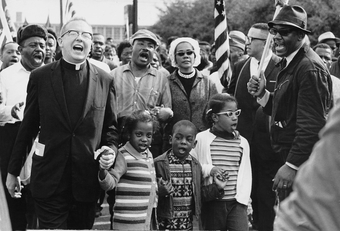
Civil Rights Movement
The right to assembly protects citizens’ rights to gather together to peacefully protest. This right was frequently exercised during the Civil Rights Movement (depicted here).
Post-materialist values emphasize non-material values like freedom and the ability to express oneself. The rising prosperity of the post-WWII years fostered these values by liberating people from the overriding concern for material security. Sociologists explain the rise of post-materialist values in two ways. First, they argue that individuals pursue various goals in order of basic necessity. While people may universally aspire to freedom and autonomy, the most pressing material needs like hunger, thirst, and physical security have to be satisfied first, since they are immediately linked with survival. These materialistic goals will have priority over post-materialist goals like belonging, esteem, and aesthetic and intellectual satisfaction. Once satisfaction has been achieved from these material survival needs, focus will gradually shift to the nonmaterial.
Second, sociologists suggest that people’s basic values are largely fixed when they reach adulthood, and change relatively little thereafter. For example, those who experience economic scarcity in childhood may as adults place a high value on meeting economic needs (such as valuing economic growth above protecting the environment) and on safety needs (such as supporting more authoritarian styles of leadership or exhibiting strong feelings of national pride—e.g., maintaining a strong army or willingness to sacrifice civil liberties for the sake of law and order). On the other hand, those who mainly experienced sustained material affluence during youth might give high priority to values such as individual improvement, personal freedom, citizen input in government decisions, the ideal of a society based on humanism, and maintaining a clean and healthy environment. Because values are set when people are young, value change can be slow. The values we see emerging today may depend on material conditions nearly a generation ago.
3.5.5: Culture Wars
In American usage, “culture war” refers to the claim that there is a conflict between those conservative and liberal values.
Learning Objective
Support the notion of a culture war by giving an example from your own contemporary society
Key Points
- A culture war is a struggle between two sets of conflicting cultural values.
- Italian Marxist Antonio Gramsci argued for a culture war in which anti-capitalist elements seek to gain a dominant voice in the mass media, education, and other mass institutions.
- Members of the religious right accused their political opponents of undermining tradition, Western civilization, and family values.
- James Davison Hunter argued that on an increasing number of “hot-button” defining issues, such as abortion, gun politics, separation of church and state, privacy, recreational drug use, homosexuality, and censorship issues, there existed two definable polarities.
- James Davison Hunter argued that on an increasing number of “hot-button” defining issues — abortion, gun politics, separation of church and state, privacy, recreational drug use, homosexuality, censorship issues — there existed two definable polarities.
Key Terms
- kulturkampf
-
A conflict between secular and religious authorities, especially the struggle between the Roman Catholic Church and the German government under Bismarck.
- progressive
-
Favoring or promoting progress; advanced.
- religious right
-
The religious or Christian right is a term used in the United States to describe right-wing Christian political groups that are characterized by their strong support of socially conservative policies. Christian conservatives principally seek to apply their understanding of the teachings of Christianity to politics and public policy by proclaiming the value of those teachings and/or by seeking to use those teachings to influence law and public policy.
Example
- At the 1992 Republican National Convention, conservative pundit Patrick Buchanan gave a landmark speech that is now often referred to as his “culture war speech. ” In it, he defined the battle lines between the two sides in the culture war, which he claimed was being fought by Republicans and Democrats. On one side, Republicans (and their 1992 presidential candidate George H.W. Bush) believed in the importance of religion and traditional family values. They wanted parents to have the option of sending children to private, religious schools (at state expense), and they opposed legalized abortion or equal rights for gay and lesbian people.
A culture war is a struggle between two sets of conflicting cultural values. This can be framed to describe west versus east, rural versus urban, or traditional values versus progressive secularism. The concept of a culture war has been in use in English since at least its adoption as a calque (loan translation) to refer to the German “Kulturkampf.”
Italian Marxist Antonio Gramsci presented in the 1920s a theory of cultural hegemony. He stated that a culturally diverse society can be dominated by one class who has a monopoly over the mass media and popular culture, and Gramsci argued for a culture war in which anti-capitalist elements seek to gain a dominant voice in the mass media, education, and other mass institutions.
As an American phenomenon, it originated in the 1920s when urban and rural American values came into clear conflict. In American usage, the term culture war is used to claim that there is a conflict between those values considered traditionalist or conservative and those considered progressive or liberal. In the 1980s, the culture war in America was characterized by the conservative climate during the presidency of Ronald Reagan. Members of the religious right often criticized academics and artists, and their works, in a struggle against what they considered indecent, subversive, and blasphemous. They often accused their political opponents of undermining tradition, Western civilization and family values.
The expression was introduced again by the 1991 publication of Culture Wars: The Struggle to Define America by James Davison Hunter, a sociologist at the University of Virginia. Hunter described what he saw as a dramatic realignment and polarization that had transformed American politics and culture. He argued that on an increasing number of “hot-button” defining issues, such as abortion, gun politics, separation of church and state, privacy, recreational drug use, homosexuality, and censorship issues, there existed two definable polarities. Furthermore, not only were there a number of divisive issues, but society had divided along essentially the same lines on these issues, so as to constitute two warring groups, defined primarily not by religion, ethnicity, social class, or even political affiliation, but rather by ideological world views.

Culture Wars
So-called red state/blue state maps have become popular for showing election results. Some suggest that the red state/blue state divide maps the battle lines in the culture wars.
3.5.6: Values as Binders
Cultures hold values that are largely shared by their members, thereby binding members together.
Learning Objective
Compose a scenario which illustrates a potential clash between personal and cultural/societal values
Key Points
- Values and value systems are guidelines that determine what is important in a society, reflecting a person’s sense of right and wrong, or what “ought” to be.
- Types of values include ethical/moral value, doctrinal/ideological (religious or political) values, social values, and aesthetic values.
- While a personal value system is held by and applied to one individual only, a communal or cultural value system is held by and applied to a community/group/society.
- Cultures have values that are largely shared by their members, thereby binding members together. Members take part in a culture even if each member’s personal values do not entirely agree with some of the normative values sanctioned in the culture.
- Values are related to the norms of a culture, but they are more global and abstract than norms.
- Values can act as blinders if people take their own personal values (or their society’s values) as universal truths and fail to recognize the diversity of values held across people and societies.
Key Terms
- value system
-
a set of consistent personal and cultural values used for the purpose of ethical or ideological integrity.
- value
-
The degree of importance given to something.
Example
- In the 1950s, few women worked outside the home. Most people, men and women alike, believed that the proper roles of women were as homemaker and mother. Gradually, though, economic necessity drove more and more women to seek jobs. As they did, many women confronted hostility, both at work and at home. They were accused of undermining the stability of the American family. Critics worried that, without mothers at home, children would grow up to be criminals. But no such catastrophe came to be. It was only the values of the time, acting as blinders, which prevented people from imagining the stability of a society in which women worked outside the home. Of course, today, the value of work has become so entrenched for women that some criticize those women who choose to stay at home instead of working. They are likewise using values as blinders.
Values and value systems are guidelines that determine what is important in a society. They can be defined as broad preferences concerning appropriate courses of action or outcomes. Values reflect a person’s sense of right and wrong, or what “ought” to be. “Equal rights for all,” “Excellence deserves admiration,” and “People should be treated with respect and dignity” are representative of values. Types of values include ethical/moral value, doctrinal/ideological (religious, political, etc.) values, social values, and aesthetic values.
Values tend to influence attitudes and behavior. For example, if you value equal rights for all and you work for an organization that treats some employees markedly better than others, this may cause internal conflict. A value system is a set of consistent personal and cultural values used for the purpose of ethical or ideological integrity. While a personal value system is held by and applied to one individual only, a communal or cultural value system is held by and applied to a community/group/society. Some communal value systems are reflected in the form of legal codes or law. As a member of a society, group, or community, an individual can hold both a personal value system and a communal value system at the same time. In this case, the two value systems (one personal and one communal) are externally consistent provided they bear no contradictions or situational exceptions between them.
Cultures have values that are largely shared by their members, thereby binding members together. Members take part in a culture even if each member’s personal values do not entirely agree with some of the normative values sanctioned in the culture. This reflects an individual’s ability to synthesize and extract aspects valuable to them from the multiple subcultures to which they belong. Values vary across individuals and cultures, and change over time; in many ways, they are aligned with belief and belief systems. Noting which people receive honor or respect can often identify the values of a society. In the US, for example, professional athletes at the top levels in some sports are honored (in the form of monetary payment) more than college professors. Surveys show that voters in the United States would be reluctant to elect an atheist as a president, suggesting that belief in God is a value.
Values are related to the norms of a culture, but they are more global and abstract than norms. Normsare rules for behavior in specific situations, while values identify what should be judged as right or wrong. Flying the national flag on a holiday is a norm, but it reflects the value of patriotism. Wearing dark clothing and appearing solemn are normative behaviors at a funeral. In certain cultures, they reflect the values of respect and support of friends and family. If a group member expresses a value that is in serious conflict with the group’s norms, the group’s authority may carry out various ways of encouraging conformity or stigmatizing the non-conforming behavior of its members. For example, transgender individuals hold the value of freedom to identify and express their gender as they choose; however this value is not shared by much of society, and discriminatory laws and practices prevent this freedom.
Values can act as blinders if people take their own personal values (or their society’s values) as universal truths and fail to recognize the diversity of values held across people and societies. They may believe their values determine the only way to understand and act in the world, when, in fact, different people and different societies may have widely divergent values.

Blinders
Values can act as blinders if people fail to recognize the diversity of values held across people and cultures, and assume their own society’s values are universal truths.
3.5.7: Ideal vs. Real Culture
Any given culture contains a set of values that determine what is important to the society; these values can be idealized or realized.
Learning Objective
Compare the idea of an idealized and a realized value system
Key Points
- Ideal values are absolute; they bear no exceptions. These values can be codified as a strict set of proscriptions on behavior.
- A realized value system contains exceptions to resolve the contradictions between ideal values and practical realities in everyday circumstances.
- Whereas we might refer to ideal values when listing American values (or even our own values), the values that we uphold in daily life tend to be real values.
Key Terms
- real values
-
values that contain exceptions to resolve the contradictions inherent between ideal values and practical realities.
- ideal values
-
absolute values that bear no exceptions and can be codified as a strict set of proscriptions on behavior.
Example
- In America, ideal values include marriage and monogamy based on romantic love. But in reality, many marriages are based on something other than romantic love: money or convenience, for instance. And in reality, few marriages endure for life as monogamous couplings. Many spouses have affairs or divorce. None of this is to say that monogamous marriages based on romantic love do not exist. But such marriages are not universal, despite our value ideals.
Any given culture contains a set of values and value systems that determine what is important to the society as a whole. When we talk about American values, we often have in mind a set of ideal values. Ideal values are absolute; they bear no exceptions. These values can be codified as a strict set of proscriptions on behavior, and those who hold to their idealized value system and claim no exceptions are often referred to as absolutists.
An example of an ideal value is the idea of marriage and monogamy based on romantic love . In reality, many marriages are based on things other than romantic love (such as money, convenience, or social expectation), and many end in divorce. While monogamous marriages based on romantic love certainly do exist, such marriages are not universal, despite our value ideals.

The Ideal Marriage?
In ideal culture, marriage is forever, but in real culture, many marriages end in divorce.
Few things in life exist without exception. Along with every value system comes exceptions to those values. Abstract exceptions serve to reinforce the ranking of values; their definitions are generalized enough to be relevant to any and all situations. Situational exceptions, on the other hand, are ad hoc and pertain only to specific situations. With these exceptions, real values emerge. A realized value system, as opposed to an ideal value system, contains exceptions to resolve the contradictions between ideal values and practical realities in everyday circumstances.
Whereas we might refer to ideal values when listing American values (or even our own values), the values that we uphold in daily life tend to be real values. The difference between these two types of systems can be seen when people state that they hold one value system, yet in practice deviate from it, thus holding a different value system. For example, a religion lists an absolute set of values, while the practice of that religion may include exceptions.
